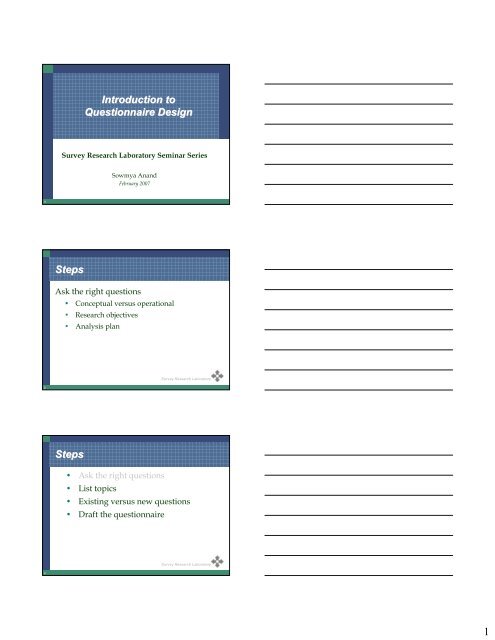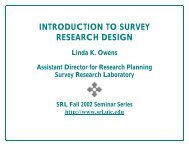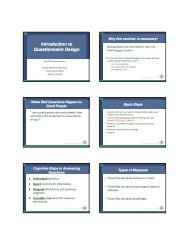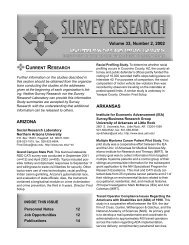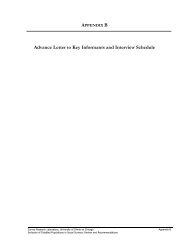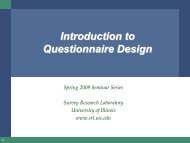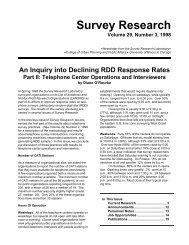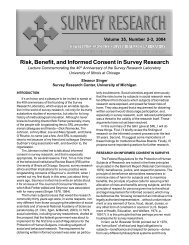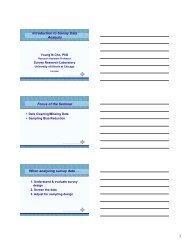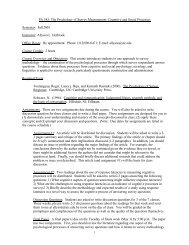Introduction to Questionnaire Design Steps Steps - Survey Research ...
Introduction to Questionnaire Design Steps Steps - Survey Research ...
Introduction to Questionnaire Design Steps Steps - Survey Research ...
You also want an ePaper? Increase the reach of your titles
YUMPU automatically turns print PDFs into web optimized ePapers that Google loves.
<strong>Introduction</strong> <strong>to</strong><br />
<strong>Questionnaire</strong> <strong>Design</strong><br />
<strong>Survey</strong> <strong>Research</strong> Labora<strong>to</strong>ry Seminar Series<br />
Sowmya Anand<br />
February 2007<br />
1<br />
<strong>Steps</strong><br />
Ask the right questions<br />
• Conceptual versus operational<br />
• <strong>Research</strong> objectives<br />
• Analysis plan<br />
<strong>Survey</strong> <strong>Research</strong> Labora<strong>to</strong>ry<br />
2<br />
<strong>Steps</strong><br />
• Ask the right questions<br />
• List <strong>to</strong>pics<br />
• Existing versus new questions<br />
• Draft the questionnaire<br />
<strong>Survey</strong> <strong>Research</strong> Labora<strong>to</strong>ry<br />
3<br />
1
Measures<br />
• Those that ask about behaviors or facts<br />
• Those that ask about psychological states<br />
or attitudes<br />
• Those that ask about knowledge<br />
<strong>Survey</strong> <strong>Research</strong> Labora<strong>to</strong>ry<br />
4<br />
Cognitive <strong>Steps</strong> in Answering Questions<br />
1. Understand question.<br />
2. Search memory for information.<br />
3. Integrate information in<strong>to</strong> summary<br />
judgment.<br />
4. Translate judgment on<strong>to</strong> response<br />
alternatives.<br />
“Optimizing”<br />
<strong>Survey</strong> <strong>Research</strong> Labora<strong>to</strong>ry<br />
5<br />
Cognitive <strong>Steps</strong><br />
• Understand question.<br />
• Search memory for information.<br />
• Integrate information in<strong>to</strong> summary judgment.<br />
• Translate judgment on<strong>to</strong> response<br />
alternatives.<br />
“Weak satisficing”<br />
<strong>Survey</strong> <strong>Research</strong> Labora<strong>to</strong>ry<br />
6<br />
2
Cognitive <strong>Steps</strong><br />
• Understand question.<br />
• Search memory for information.<br />
• Integrate information in<strong>to</strong> summary<br />
judgment.<br />
• Translate judgment on<strong>to</strong> response<br />
alternatives.<br />
“Strong satisficing”<br />
<strong>Survey</strong> <strong>Research</strong> Labora<strong>to</strong>ry<br />
7<br />
Fac<strong>to</strong>rs Influencing Satisficing<br />
• Respondent motivation<br />
• Respondent ability<br />
• Task difficulty<br />
<strong>Survey</strong> <strong>Research</strong> Labora<strong>to</strong>ry<br />
8<br />
Response Effects Explained by<br />
Satisficing<br />
Response order effects<br />
• Primacy<br />
• Recency<br />
<strong>Survey</strong> <strong>Research</strong> Labora<strong>to</strong>ry<br />
9<br />
3
Response Effects Explained by<br />
Satisficing<br />
• Response order<br />
• Acquiescence<br />
<strong>Survey</strong> <strong>Research</strong> Labora<strong>to</strong>ry<br />
10<br />
Form A (agree I’s version):<br />
Individuals are more <strong>to</strong> blame<br />
than social conditions for<br />
crime and lawlessness in this<br />
country.<br />
Form A (Agree I’s)<br />
Agree (I): 59.6%<br />
Disagree (SC): 40.4<br />
100<br />
(473)<br />
Form B (agree SCs version):<br />
Social conditions are more <strong>to</strong><br />
blame than individuals for<br />
crime and lawlessness in<br />
this country.<br />
Form B (Agree SCs)<br />
Agree (SC): 56.8%<br />
Disagree (I): 43.2<br />
100<br />
(472)<br />
<strong>Survey</strong> <strong>Research</strong> Labora<strong>to</strong>ry<br />
11<br />
Abortion should be legal.<br />
Strongly Agree Neither Disagree Strongly<br />
agree<br />
disagree<br />
Do you favor or oppose legalized abortion?<br />
Favor<br />
Oppose<br />
<strong>Survey</strong> <strong>Research</strong> Labora<strong>to</strong>ry<br />
12<br />
4
Response Effects Explained by<br />
Satisficing<br />
• Response order<br />
• Agreeing with assertions<br />
• Non-differentiation in ratings<br />
<strong>Survey</strong> <strong>Research</strong> Labora<strong>to</strong>ry<br />
13<br />
Non-differentiation<br />
How important is each of the following qualities for<br />
a child <strong>to</strong> have?<br />
Good manners<br />
Tries hard <strong>to</strong> succeed<br />
Not<br />
important<br />
1<br />
1<br />
2<br />
2<br />
3<br />
3<br />
4<br />
4<br />
5<br />
5<br />
6<br />
6<br />
Extremely<br />
important<br />
7<br />
7<br />
Is honest<br />
1<br />
2<br />
3<br />
4<br />
5<br />
6<br />
7<br />
Is neat and clean<br />
1<br />
2<br />
3<br />
4<br />
5<br />
6<br />
7<br />
Has sound judgment<br />
1<br />
2<br />
3<br />
4<br />
5<br />
6<br />
7<br />
<strong>Survey</strong> <strong>Research</strong> Labora<strong>to</strong>ry<br />
14<br />
Response Effects Explained by<br />
Satisficing<br />
• Response order<br />
• Agreeing with assertions<br />
• Non-differentiation in ratings<br />
• Saying “don’t know”<br />
<strong>Survey</strong> <strong>Research</strong> Labora<strong>to</strong>ry<br />
15<br />
5
Other Issues<br />
• Double-barreled questions<br />
Bad Question:<br />
Compared <strong>to</strong> one year ago,<br />
are you paying more, less, or<br />
about the same for your au<strong>to</strong><br />
and life insurance?<br />
Better Question:<br />
Compared <strong>to</strong> one year ago, are<br />
you now paying more, less, or<br />
about the same for…<br />
a. au<strong>to</strong> insurance?<br />
b. life insurance?<br />
<strong>Survey</strong> <strong>Research</strong> Labora<strong>to</strong>ry<br />
16<br />
Other Issues<br />
• Specify who, what, when, where and how.<br />
• For example, whose income? What’s<br />
included? Over what period of time?<br />
• “In 2002, what was your <strong>to</strong>tal household<br />
income, before taxes? Please count income<br />
from all members of your household,<br />
including wages from employment, disability,<br />
social security, and public aid.”<br />
<strong>Survey</strong> <strong>Research</strong> Labora<strong>to</strong>ry<br />
17<br />
Other Issues<br />
Specify through cues<br />
• “People drink beer in many places – for<br />
example, at home, at restaurants, at bars,<br />
sporting events, at friends’ homes, etc.<br />
During the past 30 days, did you drink any<br />
beer?”<br />
<strong>Survey</strong> <strong>Research</strong> Labora<strong>to</strong>ry<br />
18<br />
6
Other Issues<br />
Use words with singular meanings<br />
Ambiguous:<br />
Clearer:<br />
How would you compare Compared <strong>to</strong> your last<br />
how close you are <strong>to</strong> family neighborhood, do you now<br />
in your current neighborhood live closer <strong>to</strong> your family,<br />
<strong>to</strong> how close you were in are you further from your<br />
your old neighborhood? family, or are you about<br />
Would you say your family is<br />
the same distance?<br />
closer here, further here, or<br />
the same?<br />
<strong>Survey</strong> <strong>Research</strong> Labora<strong>to</strong>ry<br />
19<br />
Response Options<br />
• Should be consistent with the question<br />
• Should typically be exhaustive, including<br />
every possible answer<br />
• Categories should typically be mutually<br />
exclusive (no overlap)<br />
<strong>Survey</strong> <strong>Research</strong> Labora<strong>to</strong>ry<br />
20<br />
Constructing Response Scales<br />
• 5-7 response options<br />
• Using graphic images, such as thermometers<br />
and ladders, and card sorting for complex<br />
ratings is effective<br />
• Number of points in scale should be<br />
determined by how you intend <strong>to</strong> use the<br />
data<br />
<strong>Survey</strong> <strong>Research</strong> Labora<strong>to</strong>ry<br />
21<br />
7
Numbering vs. Labeling<br />
• Numbers alone<br />
• Partial labeling<br />
• Full labeling<br />
<strong>Survey</strong> <strong>Research</strong> Labora<strong>to</strong>ry<br />
22<br />
Middle Category<br />
• Include or omit?<br />
• Common practice <strong>to</strong> omit<br />
• Few respondents are truly in the middle on<br />
any given issue<br />
• Evidence from empirical studies<br />
• Our usual recommendation is <strong>to</strong> include it<br />
unless there are persuasive reasons <strong>to</strong><br />
exclude<br />
<strong>Survey</strong> <strong>Research</strong> Labora<strong>to</strong>ry<br />
23<br />
Open vs. Closed Questions<br />
Open-Ended Questions<br />
• Suggest no alternatives<br />
• Probing<br />
• Extensive interviewer training<br />
• Elaborate coding schemes<br />
• Expensive and time-consuming<br />
• Free exchange of ideas without bias<br />
<strong>Survey</strong> <strong>Research</strong> Labora<strong>to</strong>ry<br />
24<br />
8
Open vs. Closed Questions<br />
Closed-Ended Questions<br />
• Standardized questions and answers<br />
• Simple interviewer training<br />
• Easy <strong>to</strong> analyze<br />
• May make it <strong>to</strong>o easy <strong>to</strong> answer without thinking<br />
• May limit spontaneity<br />
• Not best when<br />
• asking for frequency of sensitive behaviors<br />
• there are numerous possible responses<br />
– role of initial question development and pretesting<br />
<strong>Survey</strong> <strong>Research</strong> Labora<strong>to</strong>ry<br />
25<br />
Good Questions<br />
• Use simple language<br />
• Try <strong>to</strong> use words with only one meaning<br />
• Ask questions about one object at a time<br />
<strong>Survey</strong> <strong>Research</strong> Labora<strong>to</strong>ry<br />
26<br />
Good Questions<br />
• Specify details - who, what, where, when<br />
• Use appropriate time frames<br />
• Provide cues <strong>to</strong> aid memory<br />
<strong>Survey</strong> <strong>Research</strong> Labora<strong>to</strong>ry<br />
27<br />
9
Good Questions<br />
• Use widely unders<strong>to</strong>od modifiers in response<br />
options<br />
• Use verbal labels<br />
• Use moderate number of response options (5-7)<br />
• Use evenly spaced response options<br />
• Show cards or repeat response options<br />
• Use pre-testing <strong>to</strong> understand cognitive<br />
processes & determine potential problems<br />
<strong>Survey</strong> <strong>Research</strong> Labora<strong>to</strong>ry<br />
28<br />
Good Questions<br />
• Minimize respondent cognitive<br />
burden<br />
• Avoid cues that Rs can use for<br />
satisficing (no opinion response<br />
options; agree-disagree questions)<br />
<strong>Survey</strong> <strong>Research</strong> Labora<strong>to</strong>ry<br />
29<br />
Question Order<br />
• Segment by <strong>to</strong>pic<br />
• Ask about related <strong>to</strong>pics <strong>to</strong>gether<br />
• Ask recall backwards in time<br />
• Use transitions when changing <strong>to</strong>pics<br />
• Give a sense of progress through the questionnaire<br />
• Leave objectionable questions (e.g., income) for<br />
the end<br />
• Put demographic questions at the end<br />
<strong>Survey</strong> <strong>Research</strong> Labora<strong>to</strong>ry<br />
30<br />
10
Evaluating Questions<br />
• Administration Difficulty<br />
• Reliability<br />
• Validity<br />
<strong>Survey</strong> <strong>Research</strong> Labora<strong>to</strong>ry<br />
31<br />
Conventional Pretest<br />
• Small sample of respondents<br />
• Train interviewers thoroughly<br />
• Experience level<br />
• Describe why the study is being done (briefly!)<br />
• Conduct interviews<br />
• Feedback from interviewers<br />
• Overall problems<br />
• Question-by-question problems<br />
• Suggestions for revision<br />
• Interviewer feedback useful even during main<br />
study<br />
<strong>Survey</strong> <strong>Research</strong> Labora<strong>to</strong>ry<br />
32<br />
Cognitive Interviewing<br />
• Think-aloud<br />
• To detect questions worded in problematic ways<br />
• lead respondents <strong>to</strong> infer meanings not intended by<br />
the researchers<br />
• make interpretation difficult and frustrating for a<br />
respondent<br />
• Respondents asked <strong>to</strong>…<br />
• Restate question in own words<br />
• Think aloud as they generate answer<br />
<strong>Survey</strong> <strong>Research</strong> Labora<strong>to</strong>ry<br />
33<br />
11
How many windows are<br />
there in your house?<br />
<strong>Survey</strong> <strong>Research</strong> Labora<strong>to</strong>ry<br />
34<br />
Cognitive Interviewing<br />
• Useful for identifying comprehension,<br />
retrieval, judgment, and mapping<br />
problems<br />
• Practice (with analyzing cognitive<br />
interview transcriptions) makes perfect<br />
<strong>Survey</strong> <strong>Research</strong> Labora<strong>to</strong>ry<br />
35<br />
I am usually pretty calm and relaxed.<br />
How accurate is this statement as a<br />
description of you?<br />
0 1 2 3 4 5 6 7 8 9 10<br />
not at all<br />
extremely don’t<br />
accurate accurate know<br />
<strong>Survey</strong> <strong>Research</strong> Labora<strong>to</strong>ry<br />
36<br />
12


